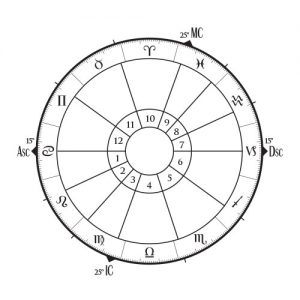Quadrant house systems, also called unequal house systems, are a form of house division that utilize the degree of the meridian as the Midheaven or Medium Coeli (M.C.). The meridian is the point where the fixed north-south axis or meridian intersects the ecliptic. The Ascendant-Descendant axis shifts somewhat over the course of a day; therefore, the intersection of the two axes creates four quadrants of varying size.
In a quadrant house system, the distance between the four angles—Ascendant, Imum Coeli (I.C.), Descendant, and Midheaven—each becomes a quadrant. These four points form the cusp of the first, fourth, seventh, and tenth houses, respectively. Each quadrant contains three houses; thus, the degrees in each quadrant are divided into three parts to determine the houses in that quadrant. Because the quadrants vary in size, the houses are rarely equal under such systems and will have a varying number of degrees. The different methods of dividing the quadrants accounts for the difference between quadrant house systems. 
In the example to the right, the ascendant is located at 15 Cancer, and so the area from 15 Cancer to 25 Virgo is divided into three, becoming the first, second, and third houses.
The area from 25 Virgo to 15 Capricorn is next divided into three, and becomes the fourth, fifth, and sixth houses, and so on.
The most common Hellenistic system of house division is a quadrant division system known today as Porphyry houses, where each quadrant is divided evenly into thirds by degrees on the ecliptic. In the Hellenistic tradition, it is most likely that this quadrant house system was derived from the works of the influential ancient authors Nechepso and Petosiris. (Brennan, p. 370). The whole sign house system, derived from other texts, became the primary form of division, while quadrant systems were often overlaid on top to aid in the application of a specific technique, such as the length of life technique. (Brennan, p. 386-392).
Medieval astrologers continued to utilize these two systems in tandem, but over time, quadrant division systems gained popularity and became the primary method of house division. (Dykes, xxvii-lix). Other popular quadrant house systems include the Campanus and Koch systems, and the Regiomontanus for horary astrology.
The best method of house division is a topic of frequent debate among modern astrologers. Among the criticisms leveled at Quadrant house systems is that natal charts utilizing these systems can contain very narrow and very wide houses, especially for those born at extreme latitudes, resulting in intercepted zodiac signs and planets.
Bibliography & Further Listening:
Brennan, Chris, Hellenistic Astrology: The Study of Fate and Fortune, Amor Fati Publications, Denver, CO, 2017.
Dykes, Benjamin N. (trans.), Works of Sahl and Masha’allah, Cazimi Press, Golden Valley, MN, 2008.
The Astrology Podcast, Episode 8, The Issue of House Division in Astrology, with Chris Brennan & Kelly Surtees, July 18, 2013.
The Astrology Podcast, Episode 227, Origins of the House Division Debate in Ancient Astrology, Chris Brennan, October 22, 2019.
Article Information
- Author(s): Claire Rootjes
- Editing or additional contributions: Chris Brennan
- Originally published: September 15, 2020
- Last updated: September 24, 2020
- Cite this article: Claire Rootjes, “Quadrant House Systems,” The Astrology Dictionary, September 15, 2020, http://theastrologydictionary.com/q/quadrant-house-systems/